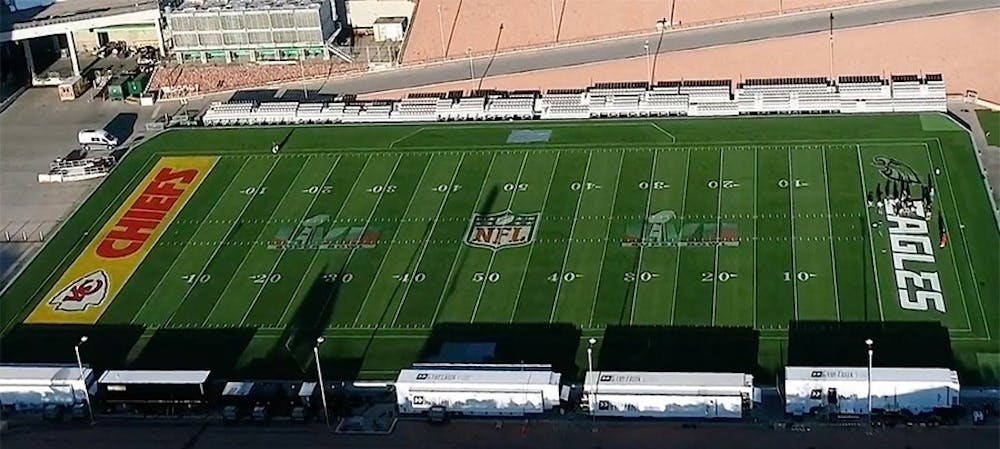Each year, millions across the globe gather together to watch the Super Bowl. We know what the Vince Lombardi Trophy is. We know the weight and significance of the game. We all turn on our TVs on game day, and see the manicured field with its painted logos and meticulously drawn hash marks.
But, how do we get to that point, with this carefully detailed setting on display for the whole world to see? In part, it's nearly a year's worth of work. Soil science. And a lot of paint. A ton of preparation goes into making the field at the Super Bowl and for many years, ASU has played a role in the process.
Pete Wozniak, athletic facilities maintenance manager for the Sun Devils, and Brian Johnson, former ASU lead groundskeeper who retired last year, have been part of the crew that paints the field for nearly three decades. The journey started in 1996 and has continued since for the pair.
Eleven-month process
The grass for this year's Super Bowl was first laid in March 2022. With a game of such magnitude, it takes time to get everything right.
"The Super Bowl is its own special circumstance," Johnson said.
Joe Traficano, who oversees sports fields for West Coast Turf in Scottsdale, said for the Super Bowl, 120,000 square feet of grass is grown. West Coast Turf is the supplier for the NFL at the Super Bowl this year.
The type of grass used this year is called Tahoma 31 Bermudagrass, said Traficano. The grass was initially developed by researchers at Oklahoma State University and is known for its drought resistance, vibrant green color and tolerance against wear.
"It's a warm season grass that is developed for hotter, warmer climates, like Arizona, Florida," Traficano said. "It's fine-textured leaf tissue. It's a perfect variety for sports fields and golf courses."
Once the grass is ready after an extensive farming process, it's harvested into rolls. These rolls of grass, 500 in total and weighing about 2,000 pounds are then placed onto the flatbeds of 50-foot-long trucks, and shipped to their final destination. It usually takes 45 to 50 truckloads to complete the job.
After the grass arrives at the stadium, it falls into the hands of NFL Field Director Ed Mangan.
The science of soil
Underneath that grass is the foundation, the soil, which plays a vital role in the development of the field. There's a whole process to soil — it's more than just dirt.
"With fertilizers, it's not just a matter of putting it down," Johnson said. "You do a soil test; there's different chemicals that are needed at certain times. One product might seem like it would work, but the chemicals are getting tied up in the soil because you're too high in another thing. Soil science is very important."
READ MORE: Months after retiring, former ASU groundskeeper keeps his green thumb
The "early" groundskeeping crew arrives at the stadium about a month ahead of the game and begins to cover the field with a new layer of sod in a process called re-sodding.
"Over the course of two to three long days, the whole field will be installed," said Wozniak, ASU's athletic facilities manager.
The sodding rolls are large, measuring 42 inches wide and 50 feet long. They're laid out across the field and using specialized machinery with a blade at the end and are pushed into place, almost like a puzzle.
"We spend a lot of time top-dressing sand and filling little seams, making it perfect," Johnson said. "When that's done, the field looks beautiful. It's all healthy grass that has been growing at the sod farm."
Over 300 gallons of paint
Over the years, the brand of paint creating hash marks and colorful end zones has varied between World Class and Pioneer. The first application of paint is put on the field well ahead of the game. The lines, numbers and hash marks are painted as far as two weeks out.
But, with so many practice performances for the halftime show in that time frame, the crew usually has to strike a delicate balance. The goal is to not put too much paint on in the beginning to compensate for the expected erosion of paint from the rehearsals.
"You don't want it caked with paint too early," Johnson said.
The artwork, the Super Bowl logos and Vince Lombardi trophies — typically personally painted by Wozniak — are first applied to the field at the 25-yard lines. Then the NFL logo at midfield before finally getting to the end zones. Stencils for the end zone are usually shipped from World Class Paints just before the conference championship games. Once those games end, the team logos are immediately painted.
In the end, three to four coats of paint are applied to the field. The last layer of paint goes down on Saturday afternoon before the game the next day.
The volume of paint used is staggering. For good reason, too. At State Farm Stadium, the field measures 234 feet wide and 403 feet long. And with it being a natural-grass playing field, more paint is required due to watering and mowing than on an artificial turf field.
Johnson estimates that three pallets with 24 five-gallon buckets of paint will be used for the Super Bowl. That's a total of 360 gallons of paint. For example, one gallon of paint covers 350 to 400 square feet. That's enough paint on the Super Bowl field to roughly cover nine 3,000-square-foot homes.
Edited by Piper Hansen, Reagan Priest and Luke Chatham.
Reach the reporter at lstanleycribe@gmail.com and @LSscribe on Twitter.
Like The State Press on Facebook and follow @statepress on Twitter.

Logan Stanley is a senior reporter at The State Press. He previously served as the managing editor of the school newspaper at Eastern Washington University. He has four years experience as a freelance journalist and is a graduate student in the master of arts of sports journalism program.




